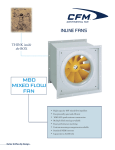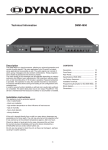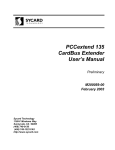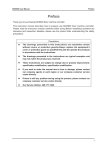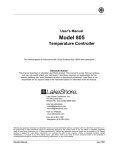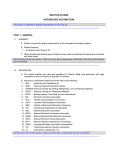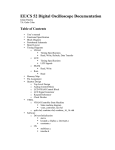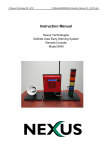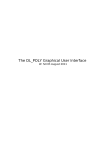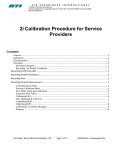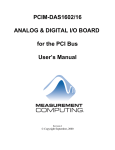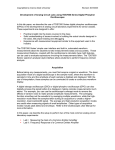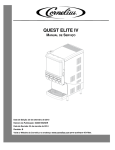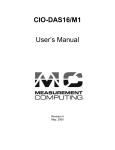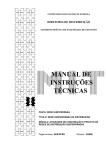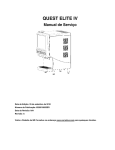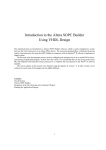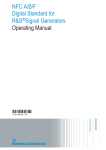Download AMCA User Manual
Transcript
佑 華 微 電 子 股 份 有 限 公 司
AMCA
User Manual
佑華微電子股份有限公司
Alpha Microelectronics Corp.
新竹市光復路二段 295 號 9 樓之 1 號
9F-1, 295, Sec. 2, Kuang Fu Rd., Hsinchu, Taiwan
電話: 03-573 6660
Tel : +886-3-573 6660
傳真: 03-573 6661
Fax: +886-3-573 6661
www..ealpha.com.tw
www.ealpha.com.tw
Rev 2.1
2004/2/12
AMCA User Manual
Table of Contents
1.
General Information ............................................................................................................................................3
1.1
1.2
1.3
1.4
1.5
2.
AMCA Preview .....................................................................................................................................................6
2.1
2.2
2.3
3.
Installation ................................................................................................................................................................... 7
Overview of Assembler ............................................................................................................................................... 7
Assembler Input/Output Files ...................................................................................................................................... 8
Using AMCA with Windows..............................................................................................................................12
4.1
5.
What AMCA Is............................................................................................................................................................. 6
What AMCA Does ....................................................................................................................................................... 6
Compatibility Issues .................................................................................................................................................... 6
AMCA – Installation and Getting Started ..........................................................................................................7
3.1
3.2
3.3
4.
About This Guide......................................................................................................................................................... 3
Recommended Reading.............................................................................................................................................. 4
The ALPHA Internet Web Site..................................................................................................................................... 5
Development Systems Customer Notification Service ................................................................................................ 5
Customer Support ....................................................................................................................................................... 5
Windows Shell Interface ............................................................................................................................................ 12
Directive Language ...........................................................................................................................................14
5.1
5.2
5.3
5.4
5.5
5.6
5.7
5.8
5.9
5.10
5.11
5.12
5.13
5.14
5.15
5.16
5.17
5.18
5.19
5.20
5.21
5.22
5.23
5.24
5.25
5.26
5.27
Highlights................................................................................................................................................................... 14
Directive Summary .................................................................................................................................................... 14
BREAK – Jump Out Point in a Logic Block................................................................................................................ 16
CASE – Define an Option Item of SWITCH............................................................................................................... 17
CBLOCK – Define a Block of Constants ................................................................................................................... 18
CONSTANT – Declare Symbol Constant .................................................................................................................. 19
CONTINUE – Ignore Statements Afterward and Start Next Loop ............................................................................. 19
DATA – Create Numeric and Text Data ..................................................................................................................... 20
DB – Declare Data of One Byte................................................................................................................................. 21
DEFAULT – Define an Unconditional Item of SWITCH.............................................................................................. 21
#DEFINE – Define a Text Substitution Label ............................................................................................................. 22
DN – Declare Data of One Nibble ............................................................................................................................. 22
DT – Define Table...................................................................................................................................................... 23
DW – Declare Data of One Word .............................................................................................................................. 23
ELSE – Begin Alternative Assembly Block to IF........................................................................................................ 24
END – End Program Block ........................................................................................................................................ 24
ENDC – End an Automatic Constant Block ............................................................................................................... 24
ENDFOR – End a For Loop....................................................................................................................................... 25
ENDIF – End Conditional Assembly Block ................................................................................................................ 25
ENDM – End a Macro Definition................................................................................................................................ 25
ENDS – Coding Convenience ................................................................................................................................... 26
ENDSW – End a Switch Block .................................................................................................................................. 26
ENDW – End a While Loop ....................................................................................................................................... 26
EQU – Define an Assembler Constant ...................................................................................................................... 27
ERROR – Issue an Error Message ........................................................................................................................... 27
EXITM – Exit from a Macro ....................................................................................................................................... 28
EXPAND – Expand Macro Listing ............................................................................................................................. 28
1
Rev 2.2
2004/2/12
AMCA User Manual
5.28
5.29
5.30
5.31
5.32
5.33
5.34
5.35
5.36
5.37
5.38
5.39
5.40
5.41
5.42
5.43
5.44
5.45
5.46
5.47
5.48
5.49
5.50
5.51
5.52
6.
Macro Language ................................................................................................................................................43
6.1
6.2
6.3
6.4
7.
FOR – Perform For Loop While Iterator Meets the Condition.................................................................................... 28
IF – Begin Conditionally Assembled Code Block....................................................................................................... 29
IFDEF – Execute If Symbol has Been Defined.......................................................................................................... 30
IFNDEF – Execute If Symbol has not Been Defined ................................................................................................. 30
#INCLUDATA – Include Binary Data File................................................................................................................... 31
#INCLUDE – Include Additional Source File ............................................................................................................. 31
LINES – Insert Listing Page Eject ............................................................................................................................. 32
LIST – Listing Options ............................................................................................................................................... 32
LOCAL – Declare Local Macro Variable .................................................................................................................... 33
MACRO – Declare Macro Definition.......................................................................................................................... 34
MAXMACRODEPTH – Define Maximum Macro Depth ............................................................................................. 34
MESSG – Create User Defined Message ................................................................................................................. 35
NEWPAGE – Insert Listing Page Eject...................................................................................................................... 35
NOEXPAND – Turn off Macro Expansion.................................................................................................................. 36
ORG – Set Program Origin........................................................................................................................................ 36
RADIX – Specify Default Radix ................................................................................................................................. 36
REPEAT – Begin a Repeat-Until Loop Block Definition............................................................................................. 37
RES – Reserve Memory............................................................................................................................................ 37
SUBTITLE – Specify Program Subtitle...................................................................................................................... 38
SWITCH – Begin Conditional Switching Assembly Block.......................................................................................... 38
TITLE – Specify Program Title................................................................................................................................... 39
#UNDEFINE – Delete a Substitution Label ............................................................................................................... 39
UNTIL – Perform Loop Until Condition is True .......................................................................................................... 40
VARIABLE – Declare Symbol Variable ...................................................................................................................... 41
WHILE – Perform Loop While Condition is True........................................................................................................ 41
Macro Syntax ............................................................................................................................................................ 43
Macro Directives........................................................................................................................................................ 43
Text Substitution ........................................................................................................................................................ 44
Macro Usage ............................................................................................................................................................. 44
Expression Syntax and Operation...................................................................................................................45
7.1
7.2
7.3
7.4
Text Strings................................................................................................................................................................ 45
Numeric Constants and Radix................................................................................................................................... 46
High/Mid/Low............................................................................................................................................................. 48
Increment/Decrement (++/--) ..................................................................................................................................... 48
Appendix A. Quick Reference .................................................................................................................................49
A.1
A.2
A.3
A.4
AMCA Quick Reference ............................................................................................................................................ 49
4-Bit MCU List ........................................................................................................................................................... 54
8-Bit MCU List ........................................................................................................................................................... 55
4-Bit MCU Instruction Set .......................................................................................................................................... 56
Appendix B. AMCA Errors/Warnings......................................................................................................................58
B.1
B.2
Errors ........................................................................................................................................................................ 58
Warnings ................................................................................................................................................................... 63
Glossary.....................................................................................................................................................................64
C.1
Terms ........................................................................................................................................................................ 64
2
Rev 2.2
2004/2/12
AMCA User Manual
1. General Information
This first chapter contains general information that will be useful to know before working with AMCA.
The information you will garner from this chapter:
• About This Guide
• Recommended Reading
• The ALPHA Internet Web Site
• Development Systems Customer Notification Service
• Customer Support
1.1 About This Guide
1.1.1 Document Layout
This document describes how to use AMCA to develop code for ALPHA micro-controller applications.
The user’s guide layout is as follows:
• Chapter 2: AMCA Preview – defines AMCA and describes what it does and how it works with other
tools.
• Chapter 3: AMCA – Installation and Getting Started – describes how to install AMCA and gives an
overview of operation.
• Chapter 4: Using AMCA with WIndows® – describes how to use AMCA with Microsoft Windows via
a Windows shell interface.
• Chapter 5: Directive Language – describes the AMCA programming language including statements,
operators, variables, and other elements.
• Chapter 6: Macro Language – describes how to use AMCA’s built-in macro processor.
• Chapter 7: Expression Syntax and Operation – provides guidelines for using complex expressions
in AMCA source files.
• Appendix A: Quick Reference – lists ALPHA MCU device instruction sets, hexadecimal to decimal
conversions, and ASCII Character Set.
• Appendix B: AMCA Errors/Warnings – contains a descriptive list of the errors, and warnings
generated by AMCA.
• Glossary – A glossary of terms used in this guide.
1.1.2 Conventions Used in This Guide
This manual uses the following documentation conventions:
• Documentation Conventions
3
Rev 2.2
2004/2/12
AMCA User Manual
• Description Represents Examples
• Code
Courier Font User-entered code or sample code
#define BITWIDTH
Angle Brackets: <>
Variables. Text you supply <label>, <exp>
Curly Brackets and Pipe Character:{ | }
Choice of mutually exclusive arguments; an OR selection errorlevel { 0 | 1 }
Lowercase Characters in Quotes
Type of data “filename”
Ellipses: ...
Used to imply, but not show, additional text that is not relevant to the example.
List [“list_option”, ...,“list_option”]
0xnnnn 0xnnnn represents a hexadecimal number where n is a hexadecimal digit 0xFFFF, 0x003B
1.1.3 Updates
All documentation becomes dated, and this user’s guide is no exception. Since AMCA, and other
ALPHA tools are constantly evolving to meet customer needs, some actual dialogs and/or tool
descriptions may differ from those in this document. Please refer to our web site to obtain the latest
documentation available.
1.2 Recommended Reading
This user’s guide describes how to use AMCA. The user may also find the data sheets for specific
micro-controller devices informative in developing firmware.
• RevisionHistory.TXT
For the latest information on using AMCA, read the REVISIONHISTORY files (ASCII text files) included
with the AMCA software. The REVISIONHISTORY files contain update information that may not be
included in this document.
• Interface
In-text Bold Characters Designates a button OK, Cancel
Uppercase Characters in Angle Brackets: < > Delimiters for special keys. <TAB>, <ESC>
• Microsoft Windows Manuals
This manual assumes that users are familiar with Microsoft Windows operating system. Many excellent
references exist for this software program, and should be consulted for general operation of Windows.
4
Rev 2.2
2004/2/12
AMCA User Manual
1.3 The ALPHA Internet Web Site
ALPHA provides on-line support on the ALPHA World Wide Web (WWW) site. The web site is used by
ALPHA as a means to make files and information easily available to customers. To view the site, the user
must have access to the Internet and a web browser, such as Netscape® Navigator or Microsoft® Internet
Explorer®.
• Connecting to the ALPHA Internet Web Site
The ALPHA website is available by using your favorite Internet browser to attach to:
http://www.ealpha.com.tw
The website provides a variety of services. Users may download files for the latest Development Tools,
Data Sheets, Application Notes, User’s Guides, and Articles. Other data available for consideration is:
• Latest ALPHA Press Releases
• Product Information
• Job Postings
1.4 Development Systems Customer Notification Service
ALPHA provided the customer notification service to help our customers keep current on ALPHA products
with the least amount of effort. You will receive email notification whenever we change, update, revise or
have errata related to that product family or development tool.
1.5 Customer Support
Users of ALPHA products can receive assistance through several channels:
• Distributor or Representative
• Field Application Engineer (FAE)
• Hot line
Customers should call their distributor, representative, or field application engineer (FAE) for support.
5
Rev 2.2
2004/2/12
AMCA User Manual
2. AMCA Preview
This chapter will give you a preview of AMCA and its capabilities.
Topics covered in this chapter:
• What AMCA Is
• What AMCA Does
• Migration Path
• Compatibility Issues
2.1 What AMCA Is
AMCA Windows-based PC application that provides a platform for developing assembly language code for
ALPHA’s microcontroller (MCU) families. Use of the ALPHA AMCA Universal Assembler requires an IBM
PC/AT® or compatible computer, Microsoft® Windows 98/NT/2000/XP. AMCA supports all MCU products
from ALPHA.
2.2 What AMCA Does
AMCA provides a universal solution for developing assembly code for all of ALPHA’s 8-bit and 4-bit
micro-controllers. Notable features include:
• All MCU Instruction Sets
• Window Interfaces
• Rich Directive Language
2.3 Compatibility Issues
AMCA is compatible with all ALPHA development systems currently in production. This includes EzCode,
AMCIDE, EzSpeech, T2E4 and T2E5. AMCA supports a clean and consistent method of specifying radix
(see Chapter 4). You are encouraged to develop new code using the methods described within this
document, even though certain older syntaxes may be supported for compatibility reasons.
6
Rev 2.2
2004/2/12
AMCA User Manual
3. AMCA – Installation and Getting Started
This chapter provides instructions for installation of AMCA on your system, and an overview of the assembler
(AMCA).
Topics covered in this chapter:
• Installation
• Overview of Assembler
• Assembler Input/Output Files
3.1 Installation
Current version of AMCA is for Windows 98/NT/2000/XP version, AMCA.EXE has a Windows GUI interface.
AMCA.EXE may be used with Windows 98/NT/2000/XP. You can obtain AMCA and supporting files from
our website. AMCA will be in a zip file. To install:
• Create a directory in which to place the files
• Unzip the AMCA files using either WinZip®
3.2 Overview of Assembler
AMCA can be used to generate absolute code that can be executed directly by a micro-controller. Absolute
code is the default output from AMCA. This process is shown in Figure 3.1. When a source file is
assembled in this manner, all values used in the source file must be defined within that source file, or in
files that have been explicitly included. If assembly proceeds without errors, a BIN file will be generated,
containing the executable machine code for the target device. This file can then be used in conjunction
with a device programmer to program the micro-controller.
Figure 3.1: Generating Absolute Code
Programmer
AMCA
CODE.ASM
CODE.BIN
MCU
7
Rev 2.2
2004/2/12
AMCA User Manual
3.3 Assembler Input/Output Files
These are the default file extensions used by AMCA and the associated utility functions.
Table 3.1: AMCA Default Extensions
Purpose
Extension
.ASM
Default source file extension input to AMCA:
<source_name>.ASM
.LST
Default output extension for listing files generated by AMCA:
<source_name>.LST
TMP
Output extension from AMCA for storing the 1st parsing job of AMCA in an assembling
session. The 2nd parsing job is based on the content of this file:
<source_name>.TMP
.ERR
Output extension from AMCA for Warning/error files:
<source_name>.ERR
Output extension from AMCA for the machine code of an application program in binary
form:
<source_name>.BIN
BIN
.HEX
Output extension from AMCA for representing BIN file in hexadecimal form:
<source_name>.HEX
.DBG
Output extension from AMCA for the symbol and debug file. This file is created for
AMCIDE debug mode:
<source_name>.DBG
3.3.1 Source Code Format (.ASM)
The source code file may be created using any ASCII text file editor. It should conform to the following
basic guidelines. Each line of the source file may contain up to four types of information:
• labels
• mnemonics
• operands
• comments
The order and position of these are important. Labels must start in column one. Mnemonics may start
in column two or beyond. Operands follow the mnemonic. Comments may follow the operands,
mnemonics or labels, and can start in any column. The maximum column width is 255 characters.
Blank(s) or a colon must separate the label and the mnemonic, and the mnemonic and the operand(s).
Multiple operands must be separated by a comma. For example:
Example 3.1: Sample AMCA Source Code (Shows multiple operands)
; sample APLHA assembler source code
;
list p=am8aa000x , c=off ,r=hex
ORG_OFF
equ
0x30
8
Rev 2.2
2004/2/12
AMCA User Manual
ORG_SUBOFF
equ
0x00
SUBPPTRADDR
equ
ORG_SUBOFF+ORG_OFF
#include "2102.h"
org 0x10
movia
0x20
jmp start
org 0x30
start:
movia
0x30
movar
0x12
end
3.3.1.1 Labels
A label must start in column 1. It may be followed by a colon (:), space, tab or the end of line.
Labels must begin with an alphabetic character or an under bar (_) and may contain alphanumeric
characters, the under bar and the ‘@’ symbol. By default they are case sensitive, but case
sensitivity may be overridden by a command line option. If a colon is used when defining a label, it
is treated as a label operator and not part of the label itself.
3.3.1.2 Mnemonics
Assembler instruction mnemonics, assembler directives and macro calls can begin in any column.
If there is a label on the same line, instructions must be separated from that label by a colon, or by
one or more spaces or tabs.
3.3.1.3 Operands
Operands must be separated from mnemonics by one or more spaces, or tabs. Multiple operands
must be separated by commas.
3.3.1.4 Comments
AMCA treats anything after a semicolon as a comment. All characters following the semicolon are
ignored through the end of the line. String constants containing a semicolon are allowed and are
not confused with comments.
3.3.2 Listing File Format (.LST)
Example 2.2: Sample AMCA Listing File (.LST)
Alpha Microelectronics Corp.
AMCA 2.12 Copyright(c) Alpha Microelectronics Corp. [Build:Aug 29 2003]
9
Rev 2.2
2004/2/12
AMCA User Manual
File=E:\MyProjects\Build\asm\amca\Sample\AMCASample.asm Date=2003/10/2, 06:22:21 pm
ADDR
OPCODE/VALUE
LINE
TAG SOURCE STATEMENT
PAGE:1
0-0001
; sample APLHA assembler source cod
0-0002
;
0-0003
list
000000030
0-0004
ORG_OFF
000000000
0-0005
ORG_SUBOFF
equ
0x00
000000030
0-0006
SUBPPTRADDR
equ
ORG_SUBOFF+ORG_OFF
0-0007
#include
1-0001
;
000000010
0-0008
org
000010
D020
0-0009
movia
000011
6030
0-0010
jmp
start
000000030
0-0011
org
0x30
000000030
0-0012
start:
000030
D030
0-0013
movia
0x30
000031
0112
0-0014
movar
0x12
0-0015
end
p=am8ba000x , c=off ,r=hex
equ
0x30
"2102.h"
0x10
0x20
AMCA 2.12 Copyright(c) Alpha Microelectronics Corp. [Build:Aug 29 2003]
File=E:\MyProjects\Build\asm\amca\Sample\AMCASample.asm Date=2003/10/2, 06:22:21 pm
SYMBOL TABLE
TYPE
VALUE
PAGE:2
__AM8BA000X
Constant 00000001
ORG_OFF
Constant 00000030
ORG_SUBOFF
Constant 00000000
start
Label
SUBPPTRADDR
00000030
Constant 00000030
SOURCE FILE TABLE
000 E:\MyProjects\Build\asm\amca\Sample\AMCASample.asm
001 E:\MyProjects\Build\asm\amca\Sample\2102.h
PROCESSOR
= AM8BA000X (8 bits)
PROGRAM ROM
DATA ROM
SRAM / SFR
= 0x00000000 - 0x0000FFFF
= 0x00000000 - 0x00FFFFFF
= 0x00000000 - 0x000000FF
10
Rev 2.2
2004/2/12
AMCA User Manual
The listing file format produced by AMCA is straightforward:
The product name and version, the assembly date and time, and the page number appear at the top of
every page. The first column of numbers contains the base address in memory where the code will be
placed. The second column displays the 32-bit value of any symbols created with the EQU, VARIABLE,
CONSTANT, or CBLOCK directives. The third column is reserved for the machine instruction. This is
the code that will be executed by the ALPHA MCU. The fourth column lists the associated source file
line number for this line. The remainder of the line is reserved for the source code line that generated
the machine code. Errors, warnings, and messages are embedded between the source lines, and
pertain to the following source line. The symbol table lists all symbols defined in the program.
3.3.3 Error File Format (.ERR)
AMCA by default generates an error file. This file can be useful when debugging your code. The format
of the messages in the error file is:
[<type>] <file> (<line>) <number> <description>
For example:
[Error] C:\PROG.ASM 7 (133) w001: Symbol not previously defined (start)
Appendix C describes the error messages generated by AMCA.
3.3.4 Hex File Formats (.HEX)
AMCA is capable of producing different hex file formats.
3.3.5 Symbol and Debug File Format (.DBG)
When AMCA is evoked by AMCIDE, it produces a DBG file for use in ICE debugging of code.
11
Rev 2.2
2004/2/12
AMCA User Manual
4. Using AMCA with Windows
This chapter is dedicated to describing the version of AMCA for Windows. This version may be run
stand-alone as a Windows shell, or within other ALPHA development tools e.g. EzCode and AMCIDE.
Topics covered in this chapter:
• Windows Shell Interface
4.1 Windows Shell Interface
AMCA for Windows provides a graphical interface for setting assembler options. It is invoked by executing
AMCA.EXE while in Windows.
Figure 4.1: AMCA Windows Shell Interface
Select a source file by typing in the name or using the Browse button. Set the various options as described
below. Then click Build to assemble the source file.
Note: When AMCA for Windows is invoked through other ALPHA development tools, the options screen is
not available. Options are passed from specific tools according to the created ASM file.
Table 4.1: Assembler Options
Option
Radix
Macro Expansion
Code Number
Case Sensitivity
Processor
Usage
Override any source file radix settings
Override any source file macro expansion settings.
Produce two extra files (O file and R file) if user checks “Code Number
Enabled” box and typed in a three-digital number.
Enable/disable case sensitivity.
Override any source file processor settings.
12
Rev 2.2
2004/2/12
AMCA User Manual
Option
Max Macro Depth
Usage
Give the max macro depth; Default value is 16 and maximum is 256.
Lines/Page
Override any source file lines per page settings; Default is 19, minimum
is 10, and maximum is 1000.
Max Loop Count
Override any source file maximum loop count settings. Default and
maximum are 256.
Config Block
Popup a setup window for hardware configuration.
Table 4.2: Assembler Extra Options:
Extra Option
Usage
/unlockrsvmem
For 4-bit MCU only. Allow the programming right in reserved memory
area
/nocfgblk
For 4-bit MCU only. Ignore the assembly time check for the existence of
configuration block file
13
Rev 2.2
2004/2/12
AMCA User Manual
5. Directive Language
This chapter describes the AMCA directive language. Directives are assembler commands that appear in the
source code but are not translated directly into opcodes. They are used to control the assembler: its input,
output, and data allocation.
5.1 Highlights
There are five basic types of directives provided by AMCA:
• Control Directives – Control directives permit sections of conditionally assembled code.
• Data Directives – Data Directives are those that control the allocation of memory and provide a way to
refer to data items symbolically, that is, by meaningful names.
• Listing Directives – Listing Directives are those directives that control the AMCA listing file format. They
allow the specification of titles, pagination, and other listing control.
• Macro Directives – These directives control the execution and data allocation within macro body
definitions.
• Object File Directives – These directives are used only when creating an object file.
5.2 Directive Summary
Table 5.1 contains a summary of directives supported by AMCA. The remainder of this chapter is
dedicated to providing a detailed description of the directives supported by AMCA. Each definition will
show:
• Syntax
• Description
• Example
Table 5.1: Directive Summary
Directive
BREAK
CASE
CBLOCK
CONSTANT
CONTINUE
Description
Syntax
Escape from a FOR, WHILE or REPEAT-UNTIL loop,
break [<Boolean expression>]
or Jump to the end of a SWITCH block
Part of a SWITCH block; must use CASE with
SWITCH
switch <expression>
case <expression 1>[,<expression 2>]
<statements>
Define a block of constants
cblock [<expr>]
Declare symbol constant
constant <label>[=<expr>,...,<label>[=<expr>] ]
Jump to the begin of FOR, WHILE or REPEAT-UNTIL
loop that contains CONTINUE directive.
continue [<Boolean expression>]
All statements behind CONTINUE in a loop are
ignored.
14
Rev 2.2
2004/2/12
AMCA User Manual
Directive
Description
Syntax
Create numeric and text data
[<label>] data <expr>,[,<expr>,...,<expr>]
[<label>] data "<text_string>"[,"<text_string>",...]
Declare data of one byte
[<label>] db <expr>[,<expr>,...,<expr>]
[<label>] db "<text_string>"[,"<text_string>",...]
DEFAULT
Part of a SWITCH block; must use DEFAULT with
SWITCH.
Begin default assembly block to SWITCH
default
<statements>
#DEFINE
Define a text substitution label
#define <name> [<value>]
#define <name> [<arg>,...,<arg>]
DN
Declare data of one nibble
[<label>] dn <expr>,[,<expr>,...,<expr>]
DT
Define table
[<label>] dt <expr>[,<expr>,...,<expr>]
[<label>] dt "<text_string>"[,"<text_string>",...]
DW
Declare data of one word
[<label>] dw <expr>[,<expr>,...,<expr>]
[<label>] dw "<text_string>"[,"<text_string>",...]
ELSE
Begin alternative assembly
block to IF
else
<statements>
END
End program block
end
End an automatic constant block
endc
End a FOR loop
endfor
ENDIF
End conditional assembly block
endif
ENDM
End a macro definition
endm
ENDS
Directive for coding convenience: presenting
ENDFOR, ENDW, ENDSW, ENDIF
ends
End conditional switching assembly block
endsw
End a WHILE loop
endw
Define an assemble constant
<label> equ <expr>
Issue an error message
error "<text_string>"
Exit from a macro
exitm
Expand macro listing
expand
Perform counting loop FOR
for <iterator> = <expr1> to <expr2> [step <expr3>]
Begin conditionally assembled code block
if <expr>
Execute if symbol has been defined
ifdef <label>
Execute If symbol has not been defined
ifndef <label>
Include binary data file
#includata "<data_file>" [,<address>]
Include additional source file
#include "<include_file>"
Re-declare line-per-page
lines <value>
Listing options
list [<list_option>,...,<list_option>]
LOCAL
Declare local macro variable
local <label>[,<label>]
MACRO
Declare macro definition
<label> macro [<arg>,...,<arg>]
DATA
DB
ENDC
ENDFOR
ENDSW
ENDW
EQU
ERROR
EXITM
EXPAND
FOR
IF
IFDEF
IFNDEF
#INCLUDATA
#INCLUDE
LINES
LIST
MAXMACRODEPTH Setup the maximum depth of macro expansion
15
Maxmacrodepth [=] <expr>
Rev 2.2
2004/2/12
AMCA User Manual
Directive
MESSG
Description
Syntax
Create user defined message
messg "<message_text>"
NEWPAGE
Re-declare line-per-page
Newpage <value>
NOEXPAND
Turn off macro expansion
noexpand
Set program origin
[<label>:] org <expr>
Specify default radix
radix <default_radix>
Begin at-least-one-time loop
Repeat
<statements>
until <Boolean expression>
RES
Reserve memory block
[<label>:] res <mem_units>
SUBTITLE
Specify program subtitle
subtitle "<sub_text>"
Begin conditional switching assembly block
switch <expr>
Specify program title
title "<title_text>"
Delete a substitution label
#undefine <label>
End at-least-one-time loop if condition is true
Repeat
<statements>
until <Boolean expression>
Declare symbol variable
variable <label>[=<expr>,...,<label>[=<expr>] ]
Perform loop WHILE condition is true
while <expr>
ORG
RADIX
REPEAT
SWITCH
TITLE
#UNDEFINE
UNTIL
VARIABLE
WHILE
5.3 BREAK – Jump Out Point in a Logic Block
5.3.1 Syntax
Syntax 1:
<for|while|repeat – loop begin>
[<statements>]
break [<Boolean expr>]
[<statements>]
<for|while|repeat – loop end>
Syntax 2:
switch <expr>
case <expr1>[,<expr2>]
[<statements>]
break [<Boolean expr>]
[<statements>]
[<case-statements>]
endsw
16
Rev 2.2
2004/2/12
AMCA User Manual
5.3.2 Description
Set the logical point in a program which will escape the running flow from a WHILE, FOR, or
REPEAT-UNIT loop. break also is used in switch block to achieve the purpose of switching among
conditional branches.
5.3.3 Example
Example 1:
for i =0 to 4
nop
break i==2
halt
endfor
Example 2:
a=1
switch a
case 1, 2
nop
break
case 1
halt
endsw
5.3.4 See Also
FOR, WHILE, REPEAT, SWITCH
5.4 CASE – Define an Option Item of SWITCH
5.4.1 Syntax
switch <expr>
case <expr1>[,<expr2>]
[<statements>]
:
:
default
[<statements>]
endsw
17
Rev 2.2
2004/2/12
AMCA User Manual
5.4.2 Description
Define an option of selection statement. Once the <expr> matched one of the conditions after
case, running flow will branch into that case item. case is part of a switch block, and must be used
with switch
5.4.3 Example
a=1
switch a
case 1, 2
nop
break
case 1
halt
endsw
5.4.4 See Also
DEFAULT, SWITCH
5.5 CBLOCK – Define a Block of Constants
5.5.1 Syntax
cblock [<expr>]
[<label>[=<increment>][,<label>[=<increment>]]]
endc
5.5.2 Description
Define a list of named constants. Each <label> is assigned a value of one higher than the previous
<label>. The purpose of this directive is to assign address offsets to many labels. The list of names
end when an ENDC directive is encountered. <expr> indicates the starting value for the first name in
the block. If no expression is found, the first name will receive a value one higher than the final name
in the previous CBLOCK. If the first CBLOCK in the source file has no <expr>, assigned values start
with zero. If <increment> is specified, then the next <label> is assigned the value of <increment>
higher than the previous <label>. Multiple names may be given on a line, separated by commas.
cblock is useful for defining constants in program and data memory.
5.5.3 Example
cblock 0x20
; name_1 will be assigned 20
name_1, name_2 ; name_2 is 21
18
Rev 2.2
2004/2/12
AMCA User Manual
name_3 =0x30, name_4 ; name_4 is assigned 30,name_4 is assigned 31.
endc
5.5.4 See Also
ENDC
5.6 CONSTANT – Declare Symbol Constant
5.6.1 Syntax
constant <label>=<expr> [...,<label>=<expr>]
5.6.2 Description
Creates symbols for use in AMCA expressions. Constants may not be reset after having once been
initialized, and the expression must be fully resolvable at the time of the assignment. This is the
principal difference between symbols declared as CONSTANT and those declared as VARIABLE.
Otherwise, constants and variables may be used interchangeably in expressions.
5.6.3 Example
variable RecLength=64
; Set Default RecLength
constant BufLength=512
; Init BufLength
:
; RecLength may
:
; be reset later
:
; in RecLength=128
:
;
constant MaxMem=RecLength+BufLength
;CalcMaxMem
5.6.4 See Also
VARIABLE
5.7 CONTINUE – Ignore Statements Afterward and Start Next Loop
5.7.1 Syntax
<for|while|repeat – loop begin>
[<statements>]
continue [<Boolean expr>]
[<statements>]
<for|while|repeat – loop end>
19
Rev 2.2
2004/2/12
AMCA User Manual
5.7.2 Description
Set a logical point in a program which will ignore statements after continue in WHILE, FOR, or
REPEAT-UNITL looping block, and jump to the begin of looping block containing continue
directive.
5.7.3 Example
for i =0 to 4
nop
continue i==2
halt
endfor
5.7.4 See Also
FOR, WHILE, REPEAT
5.8 DATA – Create Numeric and Text Data
5.8.1 Syntax
[<label>] data <expr>,[,<expr>,...,<expr>]
[<label>] data "<text_string>"[,"<text_string>",...]
[<label>] data ‘<char>’[,‘<char>’,...]
5.8.2 Description
Initialize one or more words of program memory with data. The data may be in the form of constants or
expressions. The data may also consist of ASCII character strings, <text_string>, enclosed in
single quotes for one character or double quotes for strings. Single character items are placed into the
low byte of the word. Each character in a strings occupies a word. When generating a binary file, this
directive can also be used to declare initialized data values.
5.8.3 Example
data label_1+10 ; constants
data 1,2,label_2 ; constants
data "testing 1,2,3" ; text string
data ‘N’ ; single character
5.8.4 See Also
DB, DN, DT, DW
20
Rev 2.2
2004/2/12
AMCA User Manual
5.9 DB – Declare Data of One Byte
5.9.1 Syntax
[<label>] db <expr>[,<expr>,...,<expr>]
5.9.2 Description
Reserve program memory words with packed 8-bit values. Multiple expressions continue to fill bytes
consecutively until the end of expressions. Should there be an odd number of expressions, the last
byte will be zero.
5.9.3 Example
db ’t’, 0x0f, ’e’, 0x0f, ’s’, 0x0f, ’t’
5.9.4 See Also
DATA, DN, DT, DW
5.10 DEFAULT – Define an Unconditional Item of SWITCH
5.10.1 Syntax
switch <expr>
case <expr1>[,<expr2>]
[<statements>]
:
:
default
[<statements>]
endsw
5.10.2 Description
Define an unconditional item of selection statement. Once no condition after case items matched
<expr>, running flow will go into default item. default is part of a switch block, and must be
used with switch
5.10.3 Example
a=1
switch a
case 1, 2
nop
break
21
Rev 2.2
2004/2/12
AMCA User Manual
case 1
halt
default
nop
endsw
5.10.4 See Also
CASE, SWITCH
5.11 #DEFINE – Define a Text Substitution Label
5.11.1 Syntax
#define <name> [<string>]
5.11.2 Description
This directive defines a text substitution string. Wherever <name> is encountered in the assembly
code, <string> will be substituted. Using the directive with no <string> causes a definition of
<name> to be noted internally and may be tested for using the IFDEF directive.
5.11.3 Example
#define length 20
#define control 0x19, 7
:
:
srbr control ; set bit 7 in 0x19
5.11.4 See Also
#UNDEFINE, IFDEF, IFNDEF
5.12 DN – Declare Data of One Nibble
5.12.1 Syntax
[<label>:] dn <expr> [, <expr>, ..., <expr>]
5.12.2 Description
Reserve program memory words with packed 8-bit values. Multiple expressions continue to fill
nibbles consecutively until the end of expressions. Should there not be the number of expressions
the multiple of 4, the last nibble, last two or last three nibbles will be zero.
22
Rev 2.2
2004/2/12
AMCA User Manual
5.12.3 Example
dn 0xf, 0x1, 0xf, 0x2, 0xf, 0x3, 0xf
5.12.4 See Also
DATA, DB, DT, DW
AMCA
5.13 DT – Define Table
5.13.1 Syntax
[<label>] dt <expr> [, <expr>, ..., <expr>]
5.13.2 Description
Generates a series of DW instructions, one instruction for each <expr>. Each <expr> must be an
word value. Each character in a string is stored in word length.
5.13.3 Example
dt "A Message", 0
dt FirstValue, SecondValue, EndOfValues
5.13.4 See Also
DATA, DB, DN, DW
5.14 DW – Declare Data of One Word
5.14.1 Syntax
[<label>:] dw <expr>[,<expr>,...,<expr>]
5.14.2 Description
Reserve program memory words for data, initializing that space to specific values. Values are stored
into successive memory locations and the location counter is incremented by one. Expressions may
be literal strings and are stored as described in the DATA directive.
5.14.3 Example
dw 39, "diagnostic 39", (d_list*2+d_offset)
dw diagbase-1
5.14.4 See Also
DATA, DB, DN, DT
23
Rev 2.2
2004/2/12
AMCA User Manual
5.15 ELSE – Begin Alternative Assembly Block to IF
5.15.1 Syntax
else
5.15.2 Description
Used in conjunction with an IF directive to provide an alternative path of assembly code should the
IF evaluate to false. ELSE may be used inside a regular program block or macro.
5.15.3 Example
speed macro rate
if rate < 50
dw slow
else
dw fast
endif
endm
5.15.4 See Also
ENDIF, IF
5.16 END – End Program Block
5.16.1 Syntax
end
5.16.2 Description
Indicates the end of the program.
5.16.3 Example
list p=17c42
:
; executable code
:
;
end ; end of instructions
1
5.17 ENDC – End an Automatic Constant Block
5.17.1 Syntax
endc
24
Rev 2.2
2004/2/12
AMCA User Manual
5.17.2 Description
ENDC terminates the end of a CBLOCK list. It must be supplied to terminate the list.
5.17.3 See Also
CBLOCK
5.18 ENDFOR – End a For Loop
5.18.1 Syntax
endfor
5.18.2 Description
ENDFOR terminates a FOR loop. As long as the looping counter specified by the FOR directive went
over the conditional boundary, the source code between the FOR directive and the ENDFOR directive
will be repeatedly expanded in the assembly source code stream. This directive may be used inside a
regular program block or macro.
5.18.3 See Also
FOR
5.19 ENDIF – End Conditional Assembly Block
5.19.1 Syntax
endif
5.19.2 Description
This directive marks the end of a conditional assembly block. ENDIF may be used inside a regular
program block or macro.
5.19.3 See Also
ELSE, IF
5.20 ENDM – End a Macro Definition
5.20.1 Syntax
endm
5.20.2 Description
Terminates a macro definition begun with MACRO.
25
Rev 2.2
2004/2/12
AMCA User Manual
5.20.3 Example
make_table macro arg1, arg2
dw arg1, 0 ; null terminate table name
res arg2
; reserve storage
endm
5.20.4 See Also
MACRO, EXITM
5.21 ENDS – Coding Convenience
5.21.1 Syntax
ends
5.21.2 Description
Present ENDFOR, ENDW, ENDSW, ENDIF
5.21.3 See Also
ENDFOR, ENDW, ENDSW, ENDIF
5.22 ENDSW – End a Switch Block
5.22.1 Syntax
endsw
5.22.2 Description
Terminates a SWITCH block definition begun with SWITCH.
5.22.3 Example
See the example for SWITCH
5.22.4 See Also
SWITCH
5.23 ENDW – End a While Loop
5.23.1 Syntax
endw
26
Rev 2.2
2004/2/12
AMCA User Manual
5.23.2 Description
ENDW terminates a WHILE loop. As long as the condition specified by the WHILE directive remains true,
the source code between the WHILE directive and the ENDW directive will be repeatedly expanded in
the assembly source code stream. This directive may be used inside a regular program block or
macro.
5.23.3 Example
See the example for WHILE
5.23.4 See Also
WHILE
5.24 EQU – Define an Assembler Constant
5.24.1 Syntax
<label> equ <expr>
5.24.2 Description
The value of <expr> is assigned to <label>.
5.24.3 Example
four equ 4 ; assigned the numeric value of 4 to label four
5.25 ERROR – Issue an Error Message
5.25.1 Syntax
error "<text_string>"
5.25.2 Description
<text_string> is printed in a format identical to any AMCA error message. <text_string> may
be from 1 to 80 characters.
5.25.3 Example
error_checking macro arg1
if arg1 >= 55
; if arg is out of range
error "error_checking-01 arg out of range"
endif
endm
27
Rev 2.2
2004/2/12
AMCA User Manual
5.25.4 See Also
MESSG
5.26 EXITM – Exit from a Macro
5.26.1 Syntax
exitm
5.26.2 Description
Force immediate return from macro expansion during assembly. The effect is the same as if an ENDM
directive had been encountered.
5.26.3 Example
test macro filereg
if filereg == 1 ; check for valid file
exitm
else
error "bad file assignment"
endif
endm
5.27.4 See Also
ENDM MACRO
5.27 EXPAND – Expand Macro Listing
5.27.1 Syntax
expand
5.27.2 Description
Expand all macros in the listing file. This directive is roughly equivalent to the “Macro Expansion”
assembler option, but may be disabled by the occurrence of a subsequent NOEXPAND.
5.27.3 See Also
MACRO, NOEXPAND
1
5.28 FOR – Perform For Loop While Iterator Meets the Condition
5.28.1 Syntax
for <iterator>=<expr1> to <expr2> [step <expr3>]
28
Rev 2.2
2004/2/12
AMCA User Manual
:
:
endfor
5.28.2 Description
The lines between the FOR and the ENDFOR are assembled as long as <iterator> evaluates in the
range of <expr1> to <expr2>. A FOR loop can be repeated a maximum of 256 times.
5.28.3 Example
for I=0 to 5
nop
endfor
5.28.4 See Also
ENDFOR
5.29 IF – Begin Conditionally Assembled Code Block
5.29.1 Syntax
if <expr>
5.29.2 Description
Begin execution of a conditional assembly block. If <expr> evaluates to true, the code immediately
following the IF will assemble. Otherwise, subsequent code is skipped until an ELSE directive or an
ENDIF directive is encountered. An expression that evaluates to zero is considered logically FALSE.
An expression that evaluates to any other value is considered logically TRUE. The IF and WHILE
directives operate on the logical value of an expression. A relational TRUE expression is guaranteed
to return a nonzero value, FALSE a value of zero.
5.29.3 Example
if version == 100; check current version
:
;executable cod
:
;executable cod
else
:
:
;executable cod
;executable cod
endif
29
Rev 2.2
2004/2/12
AMCA User Manual
5.29.4 See Also
ELSE, ENDIF
5.30 IFDEF – Execute If Symbol has Been Defined
5.30.1 Syntax
ifdef <label>
5.30.2 Description
If <label> has been previously defined, usually by issuing a #DEFINE directive or by setting the
value on the AMCA command line, the conditional path is taken. Assembly will continue until a
matching ELSE or ENDIF directive is encountered.
5.30.3 Example
#define testing 1 ; set testing "on"
:
:
ifdef testing
<execute test code> ; this path would be executed.
Endif
5.30.4 See Also
#DEFINE, ELSE, ENDIF, IFNDEF, #UNDEFINE
5.31 IFNDEF – Execute If Symbol has not Been Defined
5.31.1 Syntax
ifndef <label>
5.31.2 Description
If <label> has not been previously defined, or has been undefined by issuing an #UNDEFINE
directive, then the code following the directive will be assembled. Assembly will be enabled or
disabled until the next matching ELSE or ENDIF directive is encountered.
5.31.3 Example
#define testing1 ; set testing on
:
:
#undefine testing1 ; set testing off
30
Rev 2.2
2004/2/12
AMCA User Manual
ifndef testing ; if not in testing mode
: ; execute this path
:
endif
end ; end of source
5.31.4 See Also
#DEFINE, ELSE, ENDIF, IFDEF, #UNDEFINE
5.32 #INCLUDATA – Include Binary Data File
5.32.1 Syntax
#includata "<binary_data_file>"[, address]
5.32.2 Description
The specified file is read in as binary data. The effect is the same as if the entire text of the included
file were inserted into the file at the location of the #includata statement. If the includes data file
needs to be inserted at a specific location, users can specify the location by address. #includata
must be the last statement before end directive. <binary_data_file> must be enclosed in quotes.
If a fully qualified path is specified, only that path will be searched. Otherwise, the search path is:
source file directory. <binary_data_file> will becomes a label after assembled.
5.32.3 Example
#includata "c:\music\s02.sog", 0x2000 ; insert data file at 0x2000
#includata “s01” ; extension file name can be ignored
5.33 #INCLUDE – Include Additional Source File
5.33.1 Syntax
#include "<include_file>"
5.33.2 Description
The specified file is read in as source code. The effect is the same as if the entire text of the included
file were inserted into the file at the location of the include statement. Upon end-of-file, source code
assembly will resume from the original source file. <include_file> must be enclosed in quotes. If
a fully qualified path is specified, only that path will be searched. Otherwise, the search path is:
source file directory.
31
Rev 2.2
2004/2/12
AMCA User Manual
5.33.3 Example
#include "c:\sys\sysdefs.inc" ; system defs
#include “regs.h” ; register defs
5.34 LINES – Insert Listing Page Eject
5.34.1 Syntax
lines <value>
5.34.2 Description
Inserts a page eject into the listing file.
5.34.3 See Also
NEWPAGE
5.35 LIST – Listing Options
5.35.1 Syntax
list [<list_option>, ..., <list_option>]
5.35.2 Description
Occurring on a line by itself, the LIST directive has the effect of turning listing output on, if it had
been previously turned off. Otherwise, one of the following list options can be supplied to control the
assembly process or format the listing file:
Table 4.2: List Directive Options
OPTION
DEFAULT
c
On
d
f
l
DESCRIPTION
Enable/Disable case sensitivity
c=on
Enable
c=off
Disable
None
Code number settings:
d=<3-digital number>
where <3-digital number> will be the extended file name of O file and
R file.
None
Configuration block file settings:
f=<cfgblk filename>
where <cfgblk filename> is a file name string without path information
and this cfgblk file must locates in the folder of source file
19
Source file lines per page settings:
l=<line-per-page>
where <line-per-page> has default value 19; <line-per-page> >= 10
and <line-per-page> <= 1000
32
Rev 2.2
2004/2/12
AMCA User Manual
OPTION
DEFAULT
DESCRIPTION
256
Maximum looping count settings:
n=<numeric value>
where <numeric value> will prevent AMCA from the infinite directive
looping of WHILE and REPEAT
p
None
Set the processor type:
/p=<processor_type>
where <processor_type> is an ALPHA MCU device. For example,
AM4EB005x
r
HEX
source file radix settings:
/r=<radix>
where where <radix> is one of [ hex | dec | oct | bin ]
unlockrsvmem
Locked
n
nocfgblk
/unlockrsvmem
For 4-bit MCU only. Allow the programming right in reserved memory
area
Configuration /nocfgblk
Block
For 4-bit MCU only. Ignore the assembly time check for the existence
required of configuration block file
5.35.3 Example
list p=am4ea000x, c=off, r=dec
5.36 LOCAL – Declare Local Macro Variable
5.36.1 Syntax
local <label>[,<label>...]
5.36.2 Description
Declares that the specified data elements are to be considered in local context to the macro.
<label> may be identical to another label declared outside the macro definition; there will be no
conflict between the two. If the macro is called recursively, each invocation will have its own local
copy.
5.36.3 Example
<main code segment>
:
:
len equ 10 ; global version
size equ 20 ; note that a local variable may now be created and modified
test macro size
local len, label ; local len and label
len set size ; modify local len
33
Rev 2.2
2004/2/12
AMCA User Manual
label res len ; reserve buffer
len set len-20 ;
endm ; end macro
5.36.4 See Also
ENDM, MACRO
5.37 MACRO – Declare Macro Definition
5.37.1 Syntax
<label> macro [<arg>, ..., <arg>]
5.37.2 Description
A macro is a sequence of instructions that can be inserted in the assembly source code by using a
single macro call. The macro must first be defined, then it can be referred to in subsequent source
code. A macro can call another macro, or may call itself recursively.
5.37.3 Example
Read macro device, buffer, count
Movia device
movar 0x10
movia buffer
movar 0x12
movia count
movar 0x13
endm
:
:
read 1,2,3
5.37.4 See Also
ELSE, ENDIF, ENDM, EXITM, IF, LOCAL
5.38 MAXMACRODEPTH – Define Maximum Macro Depth
5.38.1 Syntax
maxmacrodepth[=]<expr>
34
Rev 2.2
2004/2/12
AMCA User Manual
5.38.2 Description
MAXMACODEPTH defines the maximum valid macro depth to <expr>. <expr> must be less than or
equal to the maximum depth 256. MAXMACODEPTH can be used more than once in a source file. Each
use redefines the maximum valid macro depth.
5.38.3 Example
list p=am4ea000x
maxmacrodepth 0x10
:
:
5.39 MESSG – Create User Defined Message
5.39.1 Syntax
messg "<message_text>"
5.39.2 Description
Causes an informational message to be printed in the listing file. Issuing a MESSG directive does not
set any error return codes.
5.39.3 Example
mssg_macro macro
messg "mssg_macro-001 invoked without argument"
endm
5.39.4 See Also
ERROR
5.40 NEWPAGE – Insert Listing Page Eject
5.40.1 Syntax
newpage <value>
5.40.2 Description
Inserts a page eject into the listing file.
5.40.3 See Also
LINE
35
Rev 2.2
2004/2/12
AMCA User Manual
5.41 NOEXPAND – Turn off Macro Expansion
5.41.1 Syntax
noexpand
5.41.2 Description
Turns off macro expansion in the listing file.
5.41.3 See Also
EXPAND
5.42 ORG – Set Program Origin
5.42.1 Syntax
[<label>:] org <expr>
5.42.2 Description
Set the program origin for subsequent code at the address defined in <expr>. If <label> is
specified, it will be given the value of the <expr>. If no ORG is specified, code generation will begin at
address zero.
5.42.3 Example
int_1: org 0x20
; Vector 20 code goes here
int_2: org int_1+0x10
; Vector 30 code goes here
5.43 RADIX – Specify Default Radix
5.43.1 Syntax
radix <default_radix>
5.43.2 Description
Sets the default radix for data expressions. The default radix is hex. Valid radix values are: hex, dec,
oct, or bin.
5.43.3 Example
radix dec
36
Rev 2.2
2004/2/12
AMCA User Manual
5.43.4 See Also
LIST
5.44 REPEAT – Begin a Repeat-Until Loop Block Definition
5.44.1 Syntax
repeat
:
:
until <expr>
5.44.2 Description
Begin a REPEAT-UNTIL block definition
5.44.3 Example
test_mac macro count
variable i
i = 0
repeat
i += 1
until i > count
endm
:
:
end
5.44.4 See Also
WHILE, UNTIL
5.45 RES – Reserve Memory
5.45.1 Syntax
[<label>:] res <mem_units>
5.45.2 Description
Causes the memory location pointer to be advanced from its current location by the value specified in
<mem_units>. <label> is assumed to be a program memory address. Address locations are
defined in words.
37
Rev 2.2
2004/2/12
AMCA User Manual
5.45.3 Example
buffer: res 64 ; reserve 64 address locations of storage
5.45.4 See Also
ORG
5.46 SUBTITLE – Specify Program Subtitle
5.46.1 Syntax
subtitle "<sub_text>"
5.46.2 Description
<sub_text> is an ASCII string enclosed in double quotes, 60 characters or less in length. This
directive establishes a second program header line for use as a subtitle in the listing output.
5.46.3 Example
subtitle "diagnostic section"
5.46.4 See Also
TITLE
5.47 SWITCH – Begin Conditional Switching Assembly Block
5.47.1 Syntax
switch <expr>
case <expr1>[,<expr2>]
[<statements>]
case < exprM>[,<exprN>]
:
:
default
[<statements>]
endsw
5.47.2 Description
Begin execution of a conditional switching assembly block. If <expr> evaluates to matching any
<exprX> after cases , the code immediately following that matched case will assemble. Otherwise,
subsequent code is skipped until a default directive or an ENDSW directive is encountered.
38
Rev 2.2
2004/2/12
AMCA User Manual
5.47.3 Example
a=1
switch a
case 1, 2
nop
break
case 1
halt
default
endsw
5.47.4 See Also
BREAK, DEFAULT
5.48 TITLE – Specify Program Title
5.48.1 Syntax
title "<title_text>"
5.48.2 Description
<title_text> is a printable ASCII string enclosed in double quotes. It must be 60 characters or
less. This directive establishes the text to be used in the top line of each page in the listing file.
5.48.3 Example
title "operational code, rev 5.0"
5.48.4 See Also
SUBTITLE
5.49 #UNDEFINE – Delete a Substitution Label
5.49.1 Syntax
#undefine <label>
5.49.2 Description
<label> is an identifier previously defined with the #DEFINE directive. It must be a valid AMCA label.
The symbol named is removed from the symbol table.
39
Rev 2.2
2004/2/12
AMCA User Manual
5.49.3 Example
#define length 20
:
:
#undefine length
5.49.4 See Also
#DEFINE, IFDEF, #INCLUDE, IFNDEF
5.50 UNTIL – Perform Loop Until Condition is True
5.50.1 Syntax
repeat
:
:
until <expr>
5.50.2 Description
The lines between the REPEAT and the UNTIL are assembled at least once, and as long as <expr>
evaluates to FALSE. A REPEAT loop can be repeated at maximum of 256 times.
5.50.3 Example
test_mac macro count
variable i
i = 0
repeat
i += 1
until i < count
endm
:
:
end
5.50.4 See Also
WHILE, REPEAT
40
Rev 2.2
2004/2/12
AMCA User Manual
5.51 VARIABLE – Declare Symbol Variable
5.51.1 Syntax
variable <label>[=<expr>][,<label>[=<expr>]...]
5.51.2 Description
Creates symbols for use in AMCA expressions. Variables and constants may be used
interchangeably in expressions. The VARIABLE directive creates a symbol that is functionally
equivalent to those created by the SET directive. The difference is that the VARIABLE directive does
not require that symbols be initialized when they are declared. Note that variable values cannot be
updated within an operand. You must place variable assignments, increments, and decrements on
separate lines.
5.51.3 Example
Please refer to the example given for the CONSTANT directive.
5.51.4 See Also
CONSTANT
5.52 WHILE – Perform Loop While Condition is True
5.52.1 Syntax
while <expr>
:
:
endw
5.52.2 Description
The lines between the WHILE and the ENDW are assembled as long as <expr> evaluates to TRUE. An
expression that evaluates to zero is considered logically FALSE. An expression that evaluates to any
other value is considered logically TRUE. A relational TRUE expression is guaranteed to return a
non-zero value; FALSE a value of zero. A WHILE loop can contain at most 100 lines and be repeated
a maximum of 256 times.
5.52.3 Example
test_mac macro count
variable i
i = 0
while i < count
41
Rev 2.2
2004/2/12
AMCA User Manual
movlw i
i += 1
endw
endm
start
test_mac 5
end
5.52.4 See Also
ENDW IF
42
Rev 2.2
2004/2/12
AMCA User Manual
6. Macro Language
Macros are user defined sets of instructions and directives that will be evaluated in-line with the assembler
source code whenever the macro is invoked. Macros consist of sequences of assembler instructions and
directives. They can be written to accept arguments, making them quite flexible. Their advantages are:
• Higher levels of abstraction, improving readability and reliability.
• Consistent solutions to frequently performed functions.
• Simplified changes.
• Improved testability.
Applications might include creating complex tables, frequently used code, and complex operations.
Topics covered in this chapter:
• Macro Syntax
• Macro Directives
• Text Substitution
• Macro Usage
6.1 Macro Syntax
AMCA macros are defined according to the following syntax:
<label> macro [<arg1>,<arg2> ..., <argn>]
:
:
endm
where <label> is a valid AMCA label and <arg> is any number of optional arguments supplied to the
macro. The values assigned to these arguments at the time the macro is invoked will be substituted
wherever the argument name occurs in the body of the macro. The body of a macro may be comprised of
AMCA directives, or AMCA Macro Directives (LOCAL for example). Refer to Chapter 4. AMCA continues to
process the body of the macro until an EXITM or ENDM directive is encountered.
Note: Forward references to macros are not permitted.
6.2 Macro Directives
There are directives that are unique to macro definitions. They cannot be used out of the macro context
(refer to Chapter 7 for details concerning these directives):
• MACRO
• LOCAL
• EXITM
• ENDM
When writing macros, you can use any of these directives PLUS any other directives supported by AMCA.
Rev 2.2
2004/2/12
43
AMCA User Manual
6.3 Text Substitution
String replacement and expression evaluation may appear within the body of a macro. Arguments may be
used anywhere within the body of the macro.
Command
Description
<arg>
Substitute the argument text supplied as part of the macro invocation.
define_table macro num_of_entry
local a = 0
while a < num_of_entry
dw 0
a += 1
endw
endm
when invoked, would generate:
dw 0
; 1st
dw 0
; 2nd
:
:
dw 0
; (num_of_entry-1)-th
dw 0
; (num_of_entry)-th
6.4 Macro Usage
Once the macro has been defined, it can be invoked at any point within the source module by using a
macro call, as described below:
<macro_name> [<arg>, ..., <arg>]
where <macro_name> is the name of a previously defined macro and arguments are supplied as required.
The macro call itself will not occupy any locations in memory. However, the macro expansion will begin at
the current memory location. Commas may be used to reserve an argument position. In this case, the
argument will be an empty string. The argument list is terminated by white space or a semicolon. The
EXITM directive (see Chapter 4) provides an alternate method for terminating a macro expansion. During a
macro expansion, this directive causes expansion of the current macro to stop and all code between the
EXITM and the ENDM directives for this macro to be ignored. If macros are nested, EXITM causes code
generation to return to the previous level of macro expansion.
44
Rev 2.2
2004/2/12
AMCA User Manual
7. Expression Syntax and Operation
This chapter describes various expression formats, syntax, and operations used by AMCA.
Topics covered in this chapter:
• Text Strings
• Numeric Constants and Radix
• Arithmetic Operators and Precedence
• High/Mid/Low and Increment/Decrement Operators
7.1 Text Strings
A “string” is a sequence of any valid ASCII character (of the decimal range of 0 to 127) enclosed by double
quotes. Strings may be of any length that will fit within a 255 column source line. If a matching quote mark
is found, the string ends. If none is found before the end of the line, the string will end at the end of the line.
While there is no direct provision for continuation onto a second line, it is generally no problem to use a
second DW directive for the next line. The DW directive will store the entire string into successive words. If a
string has an odd number of characters (bytes), the DB directive will pad the end of the string with one byte
of zero (00).
See the examples below for the object code generated by different statements involving strings.
000010 0074 0065 0073 0-0007
dw "testing output string one\n"
0074 0069 006E
0067 0020 006F
0075 0074 0070
0075 0074 0020
0073 0074 0072
0069 006E 0067
0020 006F 006E
0065 005C 006E
0-0010
000050 0074 0065 0073 0-0011
#define str "testing output string two"
data "testing first output string"
0074 0069 006E
0067 0020 0066
0069 0072 0073
0074 0020 006F
0075 0074 0070
0075 0074 0020
0073 0074 0072
0069 006E 0067
45
Rev 2.2
2004/2/12
AMCA User Manual
000080 7465 7374 696E 0-0013
db "testing first output string"
6720 6669 7273
7420 6F75 7470
7574 2073 7472
696E 6700
7.2 Numeric Constants and Radix
AMCA supports the following radix forms: hexadecimal, decimal, octal, binary, and ASCII. The default radix
is hexadecimal; the default radix determines what value will be assigned to constants in the object file
when a radix is not explicitly specified by a base descriptor. AMCA only supports unsigned constants and
the values are assumed to be positive.
Note: Intermediate values in constant expressions are treated as 32-bit unsigned integers. Whenever an
attempt is made to place a constant in a field for which it is too large, a truncation warning will be issued.
The following table presents the various radix specifications:
Table 7.1: Radix Specifications
Type
Syntax
Decimal
Hexadecimal
Octal
Example
D’<digits>’
D’100’
H’<hex_digits>’
0x<hex_digits>
<hex_digits>h
H’9f’
0x9f
9fh
O’<octal_digits>’
O’777’
Binary
B’<binary_digits>’
B’00111001’
ASCII
’<character>’
A’<character>’
’C’
A’C’
Table 6.2: Arithmetic Operators and Precedence
Operator
Example
$
Current/Return program counter
goto $ + 3
(
Left Parenthesis
1 + (d * 4)
)
Right Parenthesis
(Length + 1) * 256
!
Item NOT (logical complement)
if ! (a == b)
-
Negation (2’s complement)
-1 * Length
~
Complement
flags = ~flags
high
Return high byte of a 24-bit value
movia high 0x121314
;accumulator will contain 0x12
mid
Return mid byte of a 24-bit value
movia mid 0x121314
;accumulator will contain 0x13
low
Return low byte of a 24-bit value
movia low 0x121314
;accumulator will contain 0x14
46
Rev 2.2
2004/2/12
AMCA User Manual
Operator
Example
high0
Return low nibble of high byte of a 24-bit value
movia high0 0x123456
;accumulator will contain 0x2
high1
Return high nibble of high byte of a 24-bit value
movia high1 0x123456
;accumulator will contain 0x1
mid0
Return low nibble of middle byte of a 24-bit value
movia mid0 0x123456
;accumulator will contain 0x4
mid1
Return high nibble of middle byte of a 24-bit value
movia mid1 0x123456
;accumulator will contain 0x3
low0
Return low nibble of low byte of a 24-bit value
movia low0 0x123456
;accumulator will contain 0x6
low1
Return high nibble of low byte of a 24-bit value
movia low1 0x123456
;accumulator will contain 0x5
*
Multiply
a = b * c
/
Divide
a = b / c
%
Modulus
entry_len = tot_len % 16
+
Add
tot_len = entry_len * 8 + 1
-
Subtract
entry_len = (tot - 1) / 8
<<
Left shift
flags = flags << 1
>>
Right shift
flags = flags >> 1
>=
Greater or equal
if entry_idx >= num_entries
>
Greater than
if entry_idx > num_entries
<
Less than
if entry_idx < num_entries
<=
Less or equal
if entry_idx <= num_entries
==
Equal to
if entry_idx == num_entries
!=
Not equal to
if entry_idx != num_entries
&
Bitwise AND
flags = flags & ERROR_BIT
^
Bitwise exclusive OR
flags = flags ^ ERROR_BIT
|
Bitwise inclusive OR
flags = flags | ERROR_BIT
&&
Logical AND
if (len == 512) && (b == c)
||
Logical OR
if (len == 512) || (b == c)
=
Set equal to
entry_index = 0
+=
Add to, set equal
entry_index += 1
-=
Subtract, set equal
entry_index -= 1
*=
Multiply, set equal
entry_index *= entry_length
/=
Divide, set equal
entry_total /= entry_length
%=
Modulus, set equal
entry_index %= 8
<<=
Left shift, set equal
flags <<= 3
47
Rev 2.2
2004/2/12
AMCA User Manual
Operator
Example
Right shift, set equal
flags >>= 3
&=
AND, set equal
flags &= ERROR_FLAG
|=
Inclusive OR, set equal
flags |= ERROR_FLAG
^=
Exclusive OR, set equal
flags ^= ERROR_FLAG
++
Increment
i ++
--
Decrement
i --
>>=
7.3 High/Mid/Low
7.3.1 Syntax
high <operand>
mid <operand>
low <operand>
7.3.2 Description
These operators are used to return one byte of a multi-byte label value. This is done to handle dynamic
pointer calculations as might be used with table read and write instructions.
7.4 Increment/Decrement (++/--)
7.4.1 Syntax
<variable>++
<variable>--
7.4.2 Description
Increments or decrements a variable value. These operators can only be used on a line by themselves;
they cannot be embedded within other expression evaluation.
7.4.3 Example
LoopCount = 4
while LoopCount > 0
nop
LoopCount -Endw
48
Rev 2.2
2004/2/12
AMCA User Manual
Appendix A. Quick Reference
This appendix lists abbreviated information on AMCA and MCU instruction sets for use in developing
applications using AMCA.
Topics covered in this appendix:
• AMCA Quick Reference
• 4-Bit MCU List
• 8-Bit MCU List
• 4-Bit MCU Instruction Set
A.1 AMCA Quick Reference
The following Quick Reference Guide gives all the instructions, directives, and command list options for
AMCA Assembler.
Table A.1: AMCA Directive Language Summary
Directive
Description
Syntax
CONTROL DIRECTIVES
CONSTANT
Declare symbol constant
constant <label>[=<expr>,...,<label>[=<expr>] ]
Define a text substitution label
#define <name> [<value>]
#define <name> [<arg>,...,<arg>]
END
End program block
end
EQU
Define an assemble constant
<label> equ <expr>
ERROR
Issue an error message
error "<text_string>"
#INCLUDATA
Include binary data file
#includata "<data_file>" [,<address>]
Include additional source file
#include "<include_file>"
Listing options
list [<list_option>,...,<list_option>]
Create user defined message
messg "<message_text>"
Set program origin
[<label>:] org <expr>
LINES
Re-declare line-per-page
lines <value>
NEWPAGE
Re-declare line-per-page
Newpage <value>
Specify default radix
radix <default_radix>
Specify program subtitle
subtitle "<sub_text>"
Specify program title
title "<title_text>"
Delete a substitution label
#undefine <label>
Declare symbol variable
variable <label>[=<expr>,...,<label>[=<expr>] ]
#DEFINE
#INCLUDE
LIST
MESSG
ORG
RADIX
SUBTITLE
TITLE
#UNDEFINE
VARIABLE
CONDITIONAL ASSEMBLY
BREAK
Escape from a FOR, WHILE or REPEAT-UNTIL loop,
or Jump to the end of a SWITCH block
49
break [<Boolean expression>]
Rev 2.2
2004/2/12
AMCA User Manual
Directive
CASE
CONTINUE
Description
Part of a SWITCH block; must use CASE with
SWITCH
Syntax
switch <expression>
case <expression 1>[,<expression 2>]
<statements>
Jump to the begin of FOR, WHILE or REPEAT-UNTIL
loop that contains CONTINUE directive.
continue [<Boolean expression>]
All statements behind CONTINUE in a loop are
ignored.
Part of a SWITCH block; must use DEFAULT with
SWITCH.
Begin default assembly block to SWITCH
default
<statements>
Begin alternative assembly
block to IF
else
<statements>
End a FOR loop
endfor
ENDIF
End conditional assembly block
endif
ENDS
Directive for coding convenience: presenting ENDFOR,
ends
ENDW, ENDSW, ENDIF
DEFAULT
ELSE
ENDFOR
ENDSW
End conditional switching assembly block
endsw
End a WHILE loop
endw
Perform counting loop FOR
for <iterator> = <expr1> to <expr2> [step <expr3>]
Begin conditionally assembled code block
if <expr>
Execute if symbol has been defined
ifdef <label>
IFNDEF
Execute If symbol has not been defined
ifndef <label>
REPEAT
Begin at-least-one-time loop
Repeat
<statements>
until <Boolean expression>
SWITCH
Begin conditional switching assembly block
switch <expr>
UNTIL
End at-least-one-time loop if condition is true
Repeat
<statements>
until <Boolean expression>
WHILE
Perform loop WHILE condition is true
while <expr>
Define a block of constants
cblock [<expr>]
Create numeric and text data
[<label>] data <expr>,[,<expr>,...,<expr>]
[<label>] data "<text_string>"[,"<text_string>",...]
DB
Declare data of one byte
[<label>] db <expr>[,<expr>,...,<expr>]
[<label>] db "<text_string>"[,"<text_string>",...]
DN
Declare data of one nibble
[<label>] dn <expr>,[,<expr>,...,<expr>]
DT
Define table
[<label>] dt <expr>[,<expr>,...,<expr>]
[<label>] dt "<text_string>"[,"<text_string>",...]
DW
Declare data of one word
[<label>] dw <expr>[,<expr>,...,<expr>]
[<label>] dw "<text_string>"[,"<text_string>",...]
End an automatic constant block
endc
Reserve memory block
[<label>:] res <mem_units>
ENDW
FOR
IF
IFDEF
DATA
CBLOCK
DATA
ENDC
RES
50
Rev 2.2
2004/2/12
AMCA User Manual
Directive
Description
Syntax
MACRO
ENDM
End a macro definition
endm
EXITM
Exit from a macro
exitm
Expand macro listing
expand
LOCAL
Declare local macro variable
local <label>[,<label>]
MACRO
Declare macro definition
<label> macro [<arg>,...,<arg>]
EXPAND
MAXMACRODEPTH Setup the maximum depth of macro expansion
NOEXPAND
Maxmacrodepth [=] <expr>
Turn off macro expansion
noexpand
Table A.2: AMCA Assembler Options:
OPTION
DEFAULT
c
On
DESCRIPTION
Enable/Disable case sensitivity
c=on
Enable
c=off
Disable
None
Code number settings:
d=<3-digital number>
where <3-digital number> will be the extended file name of O file and R
file.
None
Configuration block file settings:
f=<cfgblk filename>
where <cfgblk filename> is a file name string without path information and
this cfgblk file must locates in the folder of source file
19
Source file lines per page settings:
l=<line-per-page>
where <line-per-page> has default value 19; <line-per-page> >= 10 and
<line-per-page> <= 1000
256
Maximum looping count settings:
n=<numeric value>
where <numeric value> will prevent AMCA from the infinite directive
looping of WHILE and REPEAT
p
None
Set the processor type:
/p=<processor_type>
where <processor_type> is an ALPHA MCU device. For example,
AM4EB005x
r
HEX
source file radix settings:
/r=<radix>
where where <radix> is one of [ hex | dec | oct | bin ]
unlockrsvmem
Locked
d
f
l
n
nocfgblk
/unlockrsvmem
For 4-bit MCU only. Allow the programming right in reserved memory area
/nocfgblk
Configuration
For 4-bit MCU only. Ignore the assembly time check for the existence of
block required
configuration block file
51
Rev 2.2
2004/2/12
AMCA User Manual
Table A.3: Radix Types Supported
Type
Syntax
Decimal
Example
D’<digits>’
D’100’
H’<hex_digits>’
0x<hex_digits>
<hex_digits>h
H’9f’
0x9f
9fh
Octal
O’<octal_digits>’
O’777’
Binary
B’<binary_digits>’
B’00111001’
ASCII
’<character>’
A’<character>’
’C’
A’C’
Hexadecimal
Table A.4: AMCA Arithmetic Operators
Operator
Example
$
Current/Return program counter
goto $ + 3
(
Left Parenthesis
1 + (d * 4)
)
Right Parenthesis
(Length + 1) * 256
!
Item NOT (logical complement)
if ! (a == b)
-
Negation (2’s complement)
-1 * Length
~
Complement
flags = ~flags
high
Return high byte of a 24-bit value
movia high 0x121314
;accumulator will contain 0x12
mid
Return mid byte of a 24-bit value
movia mid 0x121314
;accumulator will contain 0x13
low
Return low byte of a 24-bit value
movia low 0x121314
;accumulator will contain 0x14
high0
Return low nibble of high byte of a 24-bit value
movia high0 0x123456
;accumulator will contain 0x2
high1
Return high nibble of high byte of a 24-bit value
movia high1 0x123456
;accumulator will contain 0x1
mid0
Return low nibble of middle byte of a 24-bit value
movia mid0 0x123456
;accumulator will contain 0x4
mid1
movia mid1 0x123456
Return high nibble of middle byte of a 24-bit value ;accumulator will contain 0x3
low0
Return low nibble of low byte of a 24-bit value
movia low0 0x123456
;accumulator will contain 0x6
low1
Return high nibble of low byte of a 24-bit value
movia low1 0x123456
;accumulator will contain 0x5
*
Multiply
a = b * c
/
Divide
a = b / c
%
Modulus
entry_len = tot_len % 16
+
Add
tot_len = entry_len * 8 + 1
-
Subtract
entry_len = (tot - 1) / 8
52
Rev 2.2
2004/2/12
AMCA User Manual
Operator
Example
<<
Left shift
flags = flags << 1
>>
Right shift
flags = flags >> 1
>=
Greater or equal
if entry_idx >= num_entries
>
Greater than
if entry_idx > num_entries
<
Less than
if entry_idx < num_entries
<=
Less or equal
if entry_idx <= num_entries
==
Equal to
if entry_idx == num_entries
!=
Not equal to
if entry_idx != num_entries
&
Bitwise AND
flags = flags & ERROR_BIT
^
Bitwise exclusive OR
flags = flags ^ ERROR_BIT
|
Bitwise inclusive OR
flags = flags | ERROR_BIT
&&
Logical AND
if (len == 512) && (b == c)
||
Logical OR
if (len == 512) || (b == c)
=
Set equal to
entry_index = 0
+=
Add to, set equal
entry_index += 1
-=
Subtract, set equal
entry_index -= 1
*=
Multiply, set equal
entry_index *= entry_length
/=
Divide, set equal
entry_total /= entry_length
%=
Modulus, set equal
entry_index %= 8
<<=
Left shift, set equal
flags <<= 3
>>=
Right shift, set equal
flags >>= 3
&=
AND, set equal
flags &= ERROR_FLAG
|=
Inclusive OR, set equal
flags |= ERROR_FLAG
^=
Exclusive OR, set equal
flags ^= ERROR_FLAG
++
Increment
i ++
--
Decrement
i --
53
Rev 2.2
2004/2/12
AMCA User Manual
A.2 4-Bit MCU List
Table A.5: 4-Bit MCU List
IC type
PROG ROM
size
1
AM4DA000x
4K
1M
0x0080—0x00C0
12 I/O
2
3
4
5
6
7
8
9
10
11
12
13
14
15
16
17
18
19
20
21
22
23
AM4DB004x
AM4DC004x
AM4DC009x
AM4DC015x
AM4DC020x
AM4DC025x
AM4DC031x
AM4DC041x
AM4DC052x
AM4DC063x
AM4DC073x
AM4DC084x
AM4DD009x
AM4DD020x
AM4DD031x
AM4DD041x
AM4DD063x
AM4DD084x
AM4DD127x
AM4DD170x
AM4DD255x
AM4DD340x
2K
4K
4K
4K
4K
4K
4K
4K
4K
4K
4K
4K
4K
4K
4K
4K
4K
4K
4K
4K
4K
4K
16K
16K
32K
48K
64K
80K
96K
128K
160K
192K
224K
256K
32K
64K
96K
128K
192K
256K
384K
512K
768K
1M
0x0080—0x03FF
0x0080—0x03FF
0x0080—0x03FF
0x0080—0x03FF
0x0080—0x03FF
0x0080—0x03FF
0x0080—0x03FF
0x0080—0x03FF
0x0080—0x03FF
0x0080—0x03FF
0x0080—0x03FF
0x0080—0x03FF
0x0080—0x03FF
0x0080—0x03FF
0x0080—0x03FF
0x0080—0x03FF
0x0080—0x03FF
0x0080—0x03FF
0x0080—0x03FF
0x0080—0x03FF
0x0080—0x03FF
0x0080—0x03FF
2 I/O
4 I/O, 2 O
4 I/O, 2 O
4 I/O, 2 O
4 I/O, 2 O
4 I/O, 2 O
4 I/O, 2 O
4 I/O, 2 O
4 I/O, 2 O
4 I/O, 2 O
4 I/O, 2 O
4 I/O, 2 O
4 I/O, 4 I, 4 O
4 I/O, 4 I, 4 O
4 I/O, 4 I, 4 O
4 I/O, 4 I, 4 O
4 I/O, 4 I, 4 O
4 I/O, 4 I, 4 O
4 I/O, 4 I, 4 O
4 I/O, 4 I, 4 O
4 I/O, 4 I, 4 O
4 I/O, 4 I, 4 O
24
AM4EA000x
64K
4M
4M
24 I/O
25
26
27
28
29
30
31
32
33
34
35
36
37
38
39
AM4EB005x
AM4EB010x
AM4EC005x
AM4EC010x
AM4EC015x
AM4EC020x
AM4EC031x
AM4EC041x
AM4EC052x
AM4EC063x
AM4ED005x
AM4ED006x
AM4ED010x
AM4ED011x
AM4ED015x
8K
8K
16K
16K
16K
16K
16K
16K
16K
16K
16K
16K
32K
16K
16K
16K
32K
16K
32K
48K
64K
96K
128K
160K
192K
16K
20K
32K
32K
48K
16K
32K
16K
32K
48K
64K
96K
128K
160K
192K
16K
20K
32K
32K
48K
4 I/O
4 I/O
8 I/O
8 I/O
8 I/O
8 I/O
8 I/O
8 I/O
8 I/O
8 I/O
12 I/O
12 I/O
12 I/O
12 I/O
12 I/O
DATA ROM size Reserved Memory I/O Pin Count
54
Rev 2.2
Comment
EV chip, not
for product
EV chip, not
for product
2004/2/12
AMCA User Manual
40
41
42
43
44
45
46
47
48
49
50
51
52
53
54
55
56
57
58
59
IC type
PROG ROM
size
AM4ED020x
AM4ED031x
AM4ED041x
AM4ED052x
AM4ED063x
AM4ED073x
AM4ED084x
AM4EE010x
AM4EE015x
AM4EE020x
AM4EE031x
AM4EE041x
AM4EE063x
AM4EE084x
AM4EE106x
AM4EE127x
AM4EG127x
AM4EG170x
AM4EG255x
AM4EG340x
16K
16K
16K
16K
16K
16K
16K
16K
16K
16K
16K
16K
16K
64K
64K
64K
64K
64K
64K
64K
DATA ROM size Reserved Memory I/O Pin Count
64K
96K
128K
160K
192K
224K
256K
32K
48K
64K
96K
128K
192K
256K
320K
384K
384K
512K
768K
1M
64K
96K
128K
160K
192K
224K
256K
32K
48K
64K
96K
128K
192K
256K
320K
384K
384K
512K
768K
1M
Comment
12 I/O
12 I/O
12 I/O
12 I/O
12 I/O
12 I/O
12 I/O
16 I/O
16 I/O
16 I/O
16 I/O
16 I/O
16 I/O
16 I/O
16 I/O
16 I/O
24 I/O
24 I/O
24 I/O
24 I/O
A.3 8-Bit MCU List
Table A.6: 8-Bit MCU List
IC type
PROG ROM
size
1
AM8AB008x
64K
512K
N/A
33 I/O
2
AM8AD000x
64K
16M
N/A
33 I/O
3
AM8AG001x
64K
64K
N/A
33 I/O
4
AM8AG002x
64K
128K
N/A
33 I/O
5
AM8AG004x
64K
256K
N/A
33 I/O
DATA ROM size Reserved Memory I/O Pin Count
55
Rev 2.2
Comment
EV chip, not for
product
2004/2/12
AMCA User Manual
A.4 4-Bit MCU Instruction Set
Table A.7: 4-Bit MCU Instruction Set
OPCode
b b b b b b b b b b
9 8 7 6 5 4 3 2 1 0
Mnemonic
Description
Function
0 1 0 0 f f f f f f
MOVAF
Move the data (6’bffffff) in ACC* to F**
F Æ ACC
0 1 0 1 f f f f f f
MOVFA
Move the data (6’bffffff) in F to ACC
ACCÆ F
1 0 0 r r r r r r r
MOVAR
Move the dada (7’brrrrrrr) in ACC to R***.
ACC Æ R
1 0 1 r r r r r r r
MOVRA
Move the dada (7’brrrrrrr) in R to ACC.
R Æ ACC
1 1 0 0 0 0 i i i
MOVIA
Move the immediate value I (4’biiii) to ACC
IÆ ACC
i
0 1 1 0 0 r r r r r
ANDARA
A logic operation, AND, between the data in ACC and the data in
A CC• R Æ ACC
R. The result of operation will be restored to A.CC
0 1 1 0 1 r r r r r
ORARA
A logic operation, OR, between the data in ACC and the data in R.
ACC + R Æ ACC
The result of operation will be restored to ACC.
0 1 1 1 0 r r r r r
XORARA
1 1 0 0 0 1 i i i
i
ANDIA
1 1 0 0 1 0 i i i
i
ORIA
1 1 0 0 1 1 i i i
i
XORIA
A logic operation, XOR, between the data in ACC and the data in
ACC ㊉ R Æ ACC
R. The result of operation will be restored to ACC after operating.
A logic operation, AND, between the immediate value and the data
in ACC. The result of operation will be restored to ACC after I • ACCÆ A
operating.
A logic operation, OR, between the immediate value and the data
in ACC. The result of operation will be restored to ACC after I + ACCÆ ACC
operating.
A logic operation, XOR, between the immediate value and the data
in ACC. The result of operation will be restored to ACC after I ㊉ ACC Æ ACC
operating.
A add operation for the data in ACC, the data in R and carry
register. The result of operation will be restored to ACC after ACC + R + CÆ ACC
operating.
0 1 1 1 1 r r r r r
ADDARCA
1 1 0 1 0 r r r r r
INCRR
An increasing operation for the data in R and the result of operation
R + 1Æ R
will be restored to R after operating.
1 1 0 1 1 r r r r r
DECRR
A decreasing operation for the data in R and the result of operation
R - 1Æ R
will be restored to R after operating.
1 1 1 0 r r r r r r
SREQA
∙Skip next if R=ACC
A branch condition operation between the relation of the data in R
∙Run next instruction
and ACC.
if R ≠ ACC
1 1 1 1 0 r r r r r
SREQZ
∙Skip next if R=0
A branch condition operation to judge that the data in R if equal
∙Run next instruction
zero.
if R ≠ 0
1 1 1 1 1 0 r r r r
SAEQI
∙Skip next if ACC=I
A branch condition operation to judge that the data in R if equal the
∙Run next instruction
immediate value.
if ACC ≠ I
0 0 x x x x x x x x
JMP
Unconditional jump of program counter (PC).
X[7:0] Æ PC[7:0]
1 1 1 1 1 1 0 0 0 0
HALT
Enter sleep mode
Stop all operation in
chip
1 1 1 1 1 1 0 1 1 0
PUSH
Push PC to Stack
PC +2 Æ STK
1 1 1 1 1 1 1 0 0 1
RET
Return from subroutine without pop PCH0 & PCH1 back.
STK Æ PC
IRET
Interrupt return from interrupt subroutine with pop PCH0 & PCH1 {PCH1,
back.
STK}Æ PC
1 1 1 1 1 1 1 1 0 1
1 1 1 1 1 1 1 0 1 0
1 1 1 1 1 1 1 1 0 0
VDRDI
DTRDI
Read ROM data
increase VPR.
to
voice
latch
(22H,
Read ROM[9:4] to Data Latch (20H, 21H),
ACC and increase DPR.
56
23H,
24H)
PCH0,
∙ROM[3:0]Æ VLH0
and ∙ROM[7:4]Æ VLH1
∙ROM[9:8]Æ VLH2
∙VPR=VPR+1
ROM[3:0] to
∙ROM[3:0]Æ ACC
∙ROM[7:4]Æ TBLH1
∙ROM[9:8]Æ TBLH2
∙DPR=DPR+1
Rev 2.2
2004/2/12
AMCA User Manual
OPCode
b b b b b b b b b b
9 8 7 6 5 4 3 2 1 0
Mnemonic
1 1 1 1 1 1 1 0 0 0
DTRD
1 1 1 1 1 1 1 0 1 1
MDRDI
1 1 1 1 1 1 1 1 1 1
NOP
Description
Function
Read ROM[9:4] to Data Latch (20H, 21H), ROM[3:0] to ACC.
∙ROM[3:0]Æ ACC
∙ROM[7:4]Æ TBLH1
∙ROM[9:8]Æ TBLH2
∙ROM[3:0]Æ ACC
∙ROM[7:4]Æ TBLH1
Read ROM[9:4] to Data Latch (20H, 21H), ROM[3:0] to ACC and ∙ROM[9:8]Æ TBLH2
increase DPR. Then according to the channel bit to write TONE & ∙When ROM[0]=1,
OCT registers.
OCT=ROM[3:1] and
TONE=ROM[7:4].
∙ DPR=DPR+1
It is a mnemonic of no operation.
PC=PC+1
*: It represents that it is accumulator.
**: It represents that it is function register.
***: It represents that it is general register (ram).
57
Rev 2.2
2004/2/12
AMCA User Manual
Appendix B. AMCA Errors/Warnings
The following messages are produced by AMCA. These messages always appear in the listing file directly
above each line in which the error occurred. The messages are stored in the error file (.ERR).
Topics covered in this appendix:
• Errors
• Warnings
B.1 Errors
E0000
Encounter a recursive definition link
E0001
Defined symbol not found
E0002
Instruction redefinition is forbidden
E0003
Directive redefinition is forbidden
E0004
Cannot redefine symbol
E0005
Is a reserved word that cannot be redefined
E0006
Included file string not found
E0007
Cannot include multiple files
E0008
Invalid including string
E0009
Cannot open file
E000A
Try to undefine a null string
E000B
Ttoo many undefined symbols
E000C
Undefined symbol not found
E000D
Encounter redundant tokens
E000E
Try to use undefined symbol
E000F
Invalid symbol name
E0010
Try to modify a constant variable
E0011
User defined symbol cannot equal instruction name
E0012
User defined symbol cannot equal directive name
E0013
User defined symbol cannot equal reserved word
E0014
Divided by zero
E0015
Mod by zero
E0016
'endm' must be associated with 'macro'
E0017
Behind 'endm',no token is in need
E0018
Invalid hexadecimal number
E0019
Out of maximum value of hexadecimal number
E001A
Radix setting is unrecognized
E001B
Invalid octal number
E001C
Out of maximum value of octal number
58
Rev 2.2
2004/2/12
AMCA User Manual
E001D
Invalid decimal number
E001E
Out of maximum value of decimal number
E001F
Invalid binary number
E0020
Out of maximum value of binary number
E0021
Missing the paired quote
E0022
Invalid numeric value
E0023
Encounter an unknown operator
E0024
Need an operand
E0025
Missing the left-side parenthesis '('
E0026
Missing the left-side parenthesis '('
E0027
Unknown identifier
E0028
Cannot use unary operator
E0029
Operator is expected
E002A
Encounter an unexpected operand
E002B
Missing the right-side parenthesis ')'
E002C
Missing the operator
E002D
Unary operator is not allowed here
E002E
The left-side parenthesis '(' is required
E002F
User defined error message
E0030
Included data file is required
E0031
Included data file not found
E0032
Continue' should be in the directive loop
E0033
Case' should follow 'switch'
E0034
Missing the 'case' value
E0035
Case' exrpession not found
E0036
Constant not found
E0037
Unexpected ','
E0038
Identifier required
E0039
Invalid identifier name
E003A
Redefined constant is aborted
E003B
'=' is required before
E003C
Initial expression expected
E003D
‘break' should be in the directive loop or 'switch'
E003E
Empty 'db'
E003F
Missing initial expression
E0040
'default' should be in the 'switch'-'endsw' block
E0041
Useless token(s) encountered
59
Rev 2.2
2004/2/12
AMCA User Manual
E0042
Empty 'dw'
E0043
Initial expression not found
E0044
'else' must stand along
E0045
'else' misplaced
E0046
'end' doesn't need any other token
E0047
'endc' doesn't need any other token
E0048
'endc' must follow the 'cblock'
E0049
'endfor' must be paired with 'for'
E004A
'endfor' should follow 'for'
E004B
'endif' should follow 'if','ifdef',or 'ifndef'
E004C
'endif' must stand along
E004D
'endif' misplaced
E004E
'endsw' misplaced
E004F
'endsw' should follow 'switch'
E0050
'ends' misplaced
E0051
'endw' should follow 'while'
E0052
'endw' misplaced
E0053
'endw' must stand along
E0054
Missing the initial value of 'equ' identifier
E0055
Invalid name of 'equ' identifier
E0056
'exitm' out of the macro definition
E0057
'for' clause is not completed
E0058
Unrecognized iterator
E0059
Stop-value expression not found
E005A
Stop-expression not found
E005B
Error occurs when initial value evaluated
E005C
Stop expression not found
E005D
Error occurs when stop value evaluated
E005E
Step expression not found
E005F
Error occurs when step value evaluated
E0060
Infinite loop is prohibited
E0061
Boolean expression expected
E0062
Depended symbol not found
E0063
Too many symbols encountered
E0064
Variable not found
E0065
Is not allowed here,token ',' is expected
E0066
L-value(identifier) expected
60
Rev 2.2
2004/2/12
AMCA User Manual
E0067
Radix setting not found
E0068
Unrecognized radix setting
E0069
'repeat' must stand along
E006A
'res' needs a setting expression
E006B
Try to reserve a negative space
E006C
Expression required
E006D
Associated 'repeat' not found
E006E
Variable not found
E006F
Syntax error
E0070
Invalid macro name
E0071
Redefined macro
E0072
Too many operands present
E0073
No operand is required
E0074
Label misplaced
E0075
Expression cannot be terminated by an operator
E0076
Negative value of operand2 is not allowed
E0077
Operand2 exceeds the max value, truncated from MSB
E0078
Negative value of operand1 is not allowed
E0079
Operand1 exceeds the max value, truncated from MSB
E007A
Operand1 try to access the unimplemented SRAM
E007B
Operand1 try to access the unimplemented SFR
E007C
Try to access the unimplemented bit of SFR
E007D
Operand2 points out of the implemented SRAM size
E007E
Operand2 try to access the unimplemented SFR
E007F
Encounter a drifting label
E0080
Label cannot be redefined
E0081
Symbol is taken as a label previously
E0082
Initialized local variable cannot be redefined as label
E0083
String should be closed by the paired-double quotes
E0084
More than one 'default' presents in the 'switch' block
E0085
Is used as a macro name
E0086
Instruction jumps across the page boundary
E0087
Loading failure of instruction table
E0088
Unknown list option encountered
E0089
Option setting not found
E008A
Too many options encountered
E008B
Unrecognized option
61
Rev 2.2
2004/2/12
AMCA User Manual
E008C
Profile not found
E008D
IC reset is not allowed
E008E
Cannot use reserved memory
E008F
Overrun the program ROM size
E0090
Encounter occupied code space
E0091
Overrun the data ROM size
E0092
The expression of start address not found
E0093
Overlaid memory space is not allowed
E0094
Data file is greater than data ROM size
E0095
Cannot include data file before the processor is declared
E0096
Cannot define data before the processor declaration
E0097
Unrecognized statement
E0098
Missing the paired double quote ‘"’
E0099
Only one of 'case','default','endsw','ends' statement allowed
E009A
Program is terminated with an opened 'cblock'-scope
E009B
Program is terminated in an unfinished macro block
E009C
Macro expansion exceeds the maximum expansion depth
E009D
Expression of max macro depth not found
E009E
Maximum depth of macro expansion must be greater than 0
E009F
Current loops exceed the maximum loop count
E00A0
Is an invalid name of defined symbol
E00A1
Program is terminated without 'end'
E00A2
Processor type not found !
E00A3
Loading failure !
E00A4
Is not supported !
E00A5
Expression is out of word scale 0xffff
E00A6
Expression is out of byte scale 0xff
E00A7
Expression/char is out of nibble scale 0xf
E00A8
Empty 'dn'
E00A9
Object code exceeds the ROM word size (0x3ff)
E00AA
Cannot use configuration block
E00AB
Encounters an invalid format profile
E00AC
Config block file not found !
E00AD
Config block file is created by another ic type !
E00AE
Config block exceeds the size of reserved memory block !
E00AF
Missing the operand !
E00B0
Try to read the write-only bit of SFR
62
Rev 2.2
2004/2/12
AMCA User Manual
E00B1
Try to write the read-only bit(%d) of SFR
E00B2
Operand try to read the write-only SFR
E00B3
Operand try to write the read-only SFR
E00B4
Encounters an invalid macro argument
E00B5
Step-zero is not allowed
E00B6
Label cannot be placed here
E00B7
Empty 'df'
E00B8
Expression is out of 5-bits scale 0x1f
E00B9
Macro call needs argument(s)
E00BA
Reserved memory doesn't exist
E00BB
Space for the confirm-info is occupied at address
E00BC
Cannot call a macro behind the conditional branch
E00BD
Mld4 format is not supported
E00BE
Mld4 exceeds the addressing range of DPR
B.2 Warnings
W0000
Macro expansion is turned on already
W0001
Macro expansion is turned off already
W0002
User defined warning message
W0003
Operand2 not found,default value is used
W0004
Operand not found,default value is used
W0005
Re-defined variable
W0006
Ignored, for invalid expression, Line/Page
W0007
Operand2 accesses the partial implemented SFR
W0008
Operand1 accesses the partial implemented SFR
W0009
ORG without specified PC value is ignored
W000A
Title string not found
W000B
Too many title strings encountered
W000C
Sub-title string not found
W000D
Too many sub-title strings encountered
W000E
String should be closed by a double quotes
W000F
Reset title
W0010
Reset subtitle
W0011
The changing of case-sensitive may cause incorrect result
W0012
Object code exceeds the ROM word boundary (0x3ff)
W0013
Break by user
W0014
Confirm-information is not inserted
63
Rev 2.2
2004/2/12
AMCA User Manual
Glossary
To provide a common frame of reference, this glossary defines the terms that are used in this document. This
glossary contains definitions for the terms used in the AMCA.
C.1 Terms
Alpha Character
Alpha characters are those characters, regardless of case, that are normally contained in the alphabet: (a,
b, …, z, A, B, …, Z).
ALPHA MCU
ALPHA MCU refers to the AM4X, AM8X micro-controller families.
Alphanumeric
Alphanumeric characters include alpha characters and numbers: (0,1, …, 9).
Application
A set of software and hardware developed by the user, usually designed to be a product controlled by a
ALPHA micro-controller.
Assemble
The act of executing the AMCA macro assembler to translate source code to machine code.
Assembler Source Code
A text file that is processed by an assembler to produce a one-to-one correspondence between assembler
instructions and ALPHA MCU machine code.
Binary File
An AMCA single executable output.
Build
A function that recompiles all the source files for an application.
Control Directives
Control directives permit sections of conditionally assembled code.
Data Directives
Data Directives are those that control the allocation of memory and provide a way to refer to data items
symbolically, that is, by meaningful names.
Data RAM
General purpose file registers from RAM on the MCU device being emulated.
Directives
Directives provide control of the assembler’s operation by telling AMCA how to treat mnemonics, define
data, and format the listing file. Directives make coding easier and provide custom output according to
Rev 2.2
2004/2/12
64
AMCA User Manual
specific needs.
Expressions
Expressions are used in the operand field of the source line and may contain constants, symbols, or any
combination of constants and symbols separated by arithmetic operators.
Identifier
A function or variable name.
Initialized Data
Data which is defined with an initial value. In C, int myVar=5; defines a variable which will reside in an
initialized data section.
Listing Directives
Listing Directives are those directives that control the AMCA listing file format. They allow the specification
of base-numbering system, reserved memory access and other listing control.
Listing File
A listing file is an ASCII text file that shows the machine code generated for each assembly instruction,
AMCA directive, or macro encountered in a source file.
Local Label
A local label is one that is defined with the LOCAL directive. These labels are particular to a given instance
of the macro’s instantiation. In other words, the symbols and labels that are declared as local are purged
from the symbol table when the ENDM macro is encountered.
Macro
A macro is a collection of assembler instructions that are included in the assembly code when the macro
name is encountered in the source code. Macros must be defined before they are used; forward references
to macros are not allowed. All statements following the MACRO directive are part of the macro definition.
Labels used within the macro must be local to the macro so the macro can be called repetitively.
Macro Directives
These directives control the execution and data allocation within macro body definitions.
Mnemonics
These are instructions that are translated directly into machine code. These are used to perform arithmetic
and logical operations on data residing in program or data memory of a micro-controller. They also have
the ability to move data in and out of registers and memory as well as change the flow of program
execution. Also referred to as Opcodes.
AMCA
ALPHA Microelectronics Corporation’s MCU assembler.
Nesting Depth
65
Rev 2.2
2004/2/12
AMCA User Manual
Macros can be nested to 16 levels deep (default). Maximum depth is 256.
Object Code
The machine code that is produced from the source code after it is processed by an assembler. This code
will be the memory-resident code that will run on the ALPHA MCU in the user’s application. Object code is
stored in a binary file.
Operators
Operators are arithmetic symbols, like the plus sign ‘+’ and the minus sign ‘-’, that are used when forming
well-defined expressions. Each operator has an assigned precedence.
PC
Any IBM or compatible Personal Computer.
machine.
PC Host
The computer running Windows XP/2000 or Windows 95/98.
Precedence
Precedence is the concept that some elements of an expression get evaluated before others. Operators of
the same precedence are evaluated from left to right.
Program Memory
Memory in the emulator or simulator containing the downloaded target application firmware.
Project
A set of source files and instructions to build the object code for an application.
Radix
Radix is the base-numbering system that the assembler uses when evaluating expressions. The default
radix is hexadecimal (base 16). You can change the default radix and override the default radix with certain
radix override operators.
RAM
Random Access Memory (Data Memory).
Raw Data
The binary representation of code or data.
Recursion
This is the concept that a macro, having been defined, can call itself. Great care should be taken when
writing recursive macros; it is easy to get caught in an infinite loop where there will be no exit from the
recursion.
ROM
Read-only Memory (Program Memory).
66
Rev 2.2
2004/2/12
AMCA User Manual
Shell
The AMCA shell is a prompted input interface to the macro assembler. There is an AMCA shell for the
Windows version.
Source Code
Source code consists of ALPHA MCU instructions and AMCA directives and macros that will be translated
into machine code. This code is suitable for use by an ALPHA development system product like AMCIDE.
Source File
The ASCII text file of ALPHA MCU instructions and AMCA directives and macros (source code) that will be
translated into machine code. It is an ASCII file that can be created using any ASCII text editor.
Stack
An area in data memory where function arguments, return values, local variables, and return addresses
are stored.
Symbol
A symbol is a general purpose mechanism for describing the various pieces which comprise a program.
These pieces include function names, variable names, file names, macro names, etc.
Uninitialized Data
Data which is defined without an initial value. In C, int myVar.
NOTES:
Information contained in this publication regarding device applications and the like is intended for suggestion
only and may be superseded by updates. No representation or warranty is given and no liability is assumed by
ALPHA Microelectronics Corporation with respect to the accuracy or use of such information, or infringement of
patents or other intellectual property rights arising from such use or otherwise. Use of ALPHA’s products as
critical components in life support systems is not authorized except with express written approval by ALPHA.
No licenses are conveyed, implicitly or otherwise, under any intellectual property rights. The ALPHA logo and
name are registered trademarks of ALPHA Microelectronics Corporation and other countries. All rights
reserved. All other trademarks mentioned herein are the property of their respective companies.
2003 ALPHA Microelectronics Corporation.
All rights reserved. © 2003 ALPHA Microelectronics Corporation. Published in the TAIWAN.
67
Rev 2.2
2004/2/12




































































